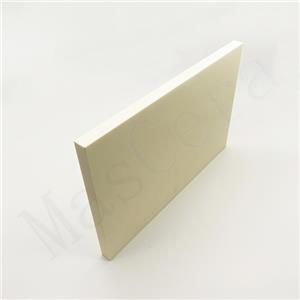The Origin and Development of Silicon Nitride Ceramics
Silicon nitride (Si3N4) is a covalent compound composed of silicon and nitrogen, discovered in 1857. In its early days, some scholars, especially in Germany, were not completely convinced of its chemical composition. However, extensive research later confirmed the correctness of this chemical formula, which is widely cited to this day. Nevertheless, for more than a century after its discovery, silicon nitride materials did not see widespread applications.
The ceramic form of silicon nitride was first developed in the United Kingdom. This ceramic material was first produced in 1955 and was primarily used for thermocouple tubes, molten metal crucibles, and rocket nozzles. This type of material is produced by pressing metal silicon powder into shape and then nitriding it by heating and exposing it to nitrogen gas, later referred to as reaction-bonded silicon nitride. Due to the presence of around 25% porosity in reaction-bonded silicon nitride, it lacked the high density needed to exhibit the superior strength and hardness properties of silicon nitride materials.
In 1960, Parr, Martin, May, and others published a comprehensive review of the properties and structure of reaction-bonded silicon nitride, outlining the techniques they developed. These techniques provided significant technical support for the subsequent development of silicon nitride ceramics.
In the 1970s, the United States initiated a large-scale silicon nitride materials development program. The U.S. Department of Defense began a five-year development project in collaboration with Ford Motor Company and Westinghouse Electric Corporation in 1971. The project aimed to explore the feasibility of using silicon nitride as a replacement for traditional engine materials and to develop ceramic gas turbine engines. Early in the project, it was recognized that conventional pressure sintering was limited to producing simple shapes of silicon nitride, while gas turbine engine components were complex. Therefore, the application of ceramic materials in engines would only be possible if the manufacturing process for silicon nitride ceramics was improved.
In 1976, Terwilliger and Lange accidentally discovered that silicon nitride powder could be sintered without applying mechanical pressure. They conducted hot-press experiments on oxygen-doped magnesium and silicon nitride powder at temperatures above normal. Even without conventional pressure, the silicon nitride powder cylinders still exhibited significant shrinkage. It was concluded that in the limited space of the graphite mold, the evaporation loss of silicon nitride was inhibited, allowing for overall densification. This discovery marked an important step in the development of high-density silicon nitride ceramics and led to the development of pressureless sintered silicon nitride.
During high-temperature sintering, silicon nitride decomposition is significant and cannot be effectively suppressed by simple powder packing. Therefore, pressure sintering of silicon nitride was developed. In 1976, Japan's Mitomo reported research on Si3N4 ceramic sintering under 10 atm nitrogen pressure at temperatures ranging from 1450°C to 1900°C. This was the earliest method of pressure sintering silicon nitride ceramics.
The various sintering techniques mentioned above are the successful results of generations of ceramic researchers' relentless efforts to address different engineering applications of silicon nitride ceramics. Recently, emerging technologies like spark plasma sintering and microwave sintering have opened up new avenues for the application of silicon nitride.
In terms of applications, whether in rockets soaring into space or cars racing on highways, or in indestructible cutting tools and robust artificial bones, silicon nitride ceramics have become an indispensable key material in industrial technology, particularly in advanced technology fields. It represents one of the major directions in the development of modern materials science.
XIAMEN MASCERA TECHNOLOGY CO., LTD. is a reputable and reliable supplier specializing in manufacturing and sales of technical ceramic parts. We provide custom production and high precision machining for a wide series of high performance ceramic materials including alumina ceramic, zirconia ceramic, silicon nitride, silicon carbide, boron nitride, aluminum nitride and machinable glass ceramic. Currently, our ceramic parts can be found in many industries like mechanical, chemical, medical, semiconductor, vehicle, electronic, metallurgy etc. Our mission is to provide the best quality ceramic parts for global users and it is a big pleasure to see our ceramic parts work efficiently in customers' specific applications. We can cooperate on both prototype and mass production, welcome to contact us if you have demands.




